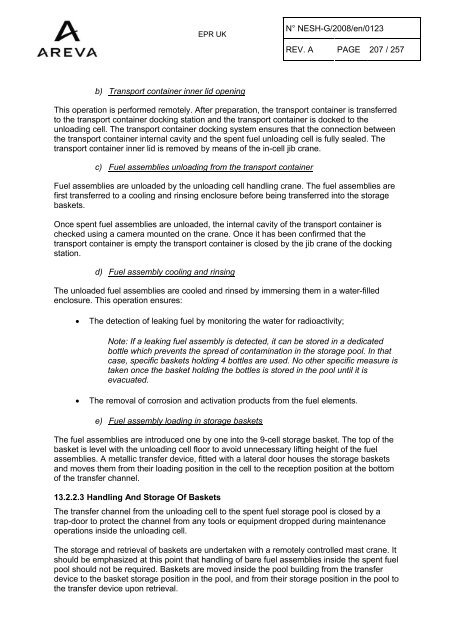Solid Radioactive Waste Strategy Report.pdf - UK EPR
Solid Radioactive Waste Strategy Report.pdf - UK EPR
Solid Radioactive Waste Strategy Report.pdf - UK EPR
Create successful ePaper yourself
Turn your PDF publications into a flip-book with our unique Google optimized e-Paper software.
<strong>EPR</strong> <strong>UK</strong><br />
N° NESH-G/2008/en/0123<br />
REV. A PAGE 207 / 257<br />
b) Transport container inner lid opening<br />
This operation is performed remotely. After preparation, the transport container is transferred<br />
to the transport container docking station and the transport container is docked to the<br />
unloading cell. The transport container docking system ensures that the connection between<br />
the transport container internal cavity and the spent fuel unloading cell is fully sealed. The<br />
transport container inner lid is removed by means of the in-cell jib crane.<br />
c) Fuel assemblies unloading from the transport container<br />
Fuel assemblies are unloaded by the unloading cell handling crane. The fuel assemblies are<br />
first transferred to a cooling and rinsing enclosure before being transferred into the storage<br />
baskets.<br />
Once spent fuel assemblies are unloaded, the internal cavity of the transport container is<br />
checked using a camera mounted on the crane. Once it has been confirmed that the<br />
transport container is empty the transport container is closed by the jib crane of the docking<br />
station.<br />
d) Fuel assembly cooling and rinsing<br />
The unloaded fuel assemblies are cooled and rinsed by immersing them in a water-filled<br />
enclosure. This operation ensures:<br />
· The detection of leaking fuel by monitoring the water for radioactivity;<br />
Note: If a leaking fuel assembly is detected, it can be stored in a dedicated<br />
bottle which prevents the spread of contamination in the storage pool. In that<br />
case, specific baskets holding 4 bottles are used. No other specific measure is<br />
taken once the basket holding the bottles is stored in the pool until it is<br />
evacuated.<br />
· The removal of corrosion and activation products from the fuel elements.<br />
e) Fuel assembly loading in storage baskets<br />
The fuel assemblies are introduced one by one into the 9-cell storage basket. The top of the<br />
basket is level with the unloading cell floor to avoid unnecessary lifting height of the fuel<br />
assemblies. A metallic transfer device, fitted with a lateral door houses the storage baskets<br />
and moves them from their loading position in the cell to the reception position at the bottom<br />
of the transfer channel.<br />
13.2.2.3 Handling And Storage Of Baskets<br />
The transfer channel from the unloading cell to the spent fuel storage pool is closed by a<br />
trap-door to protect the channel from any tools or equipment dropped during maintenance<br />
operations inside the unloading cell.<br />
The storage and retrieval of baskets are undertaken with a remotely controlled mast crane. It<br />
should be emphasized at this point that handling of bare fuel assemblies inside the spent fuel<br />
pool should not be required. Baskets are moved inside the pool building from the transfer<br />
device to the basket storage position in the pool, and from their storage position in the pool to<br />
the transfer device upon retrieval.

















